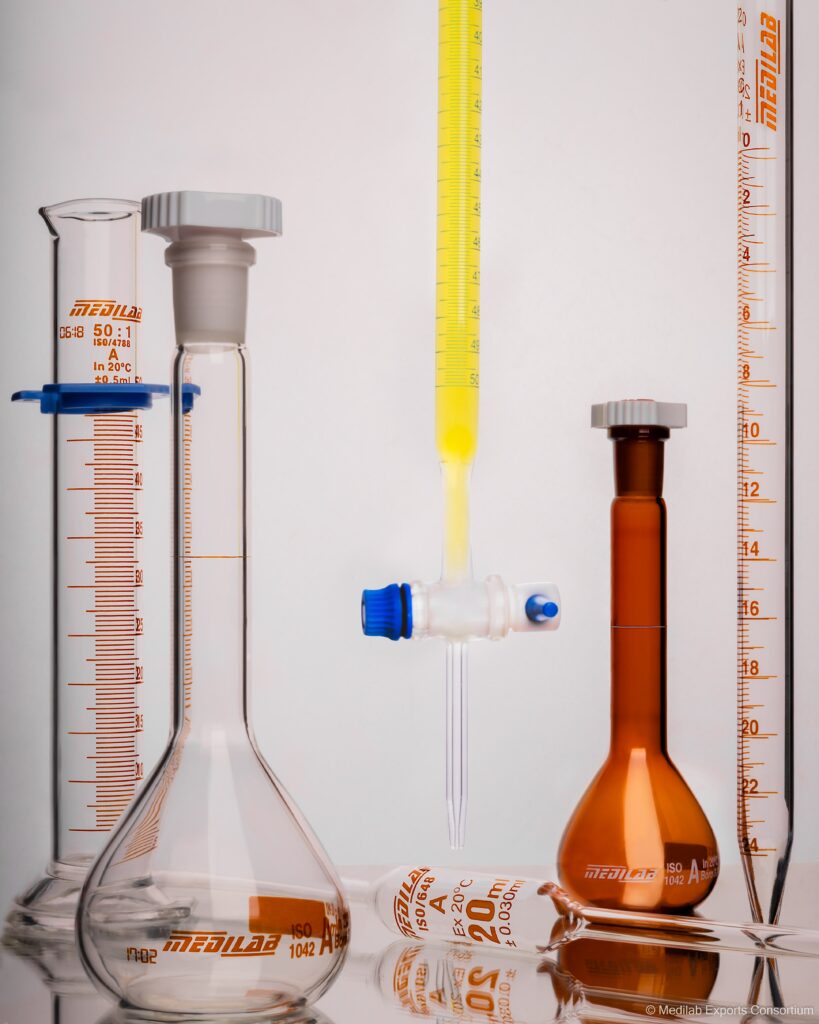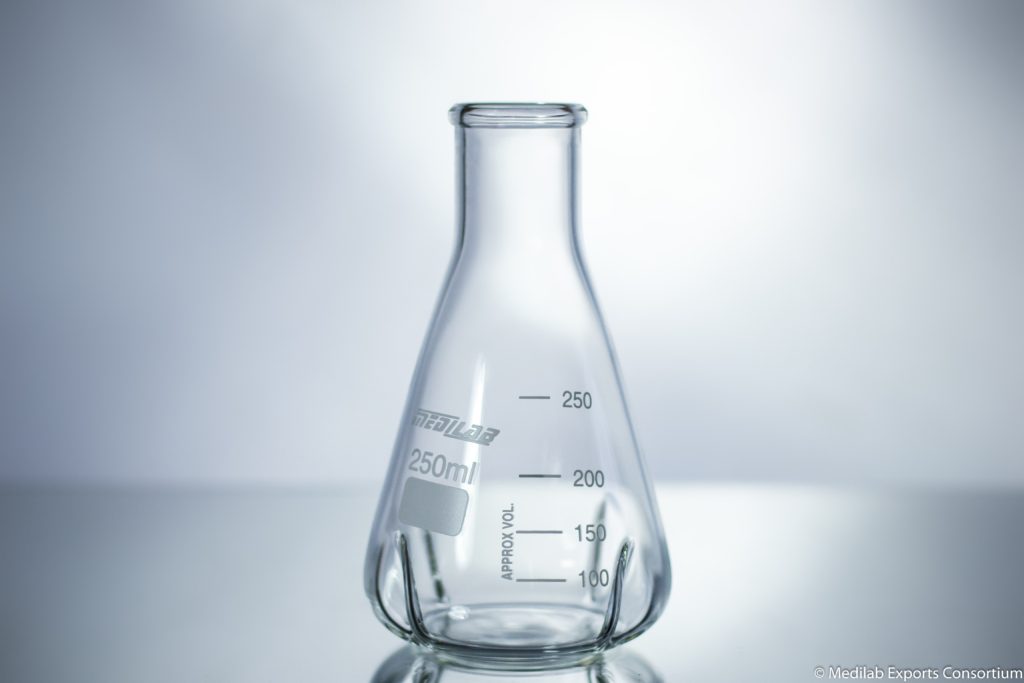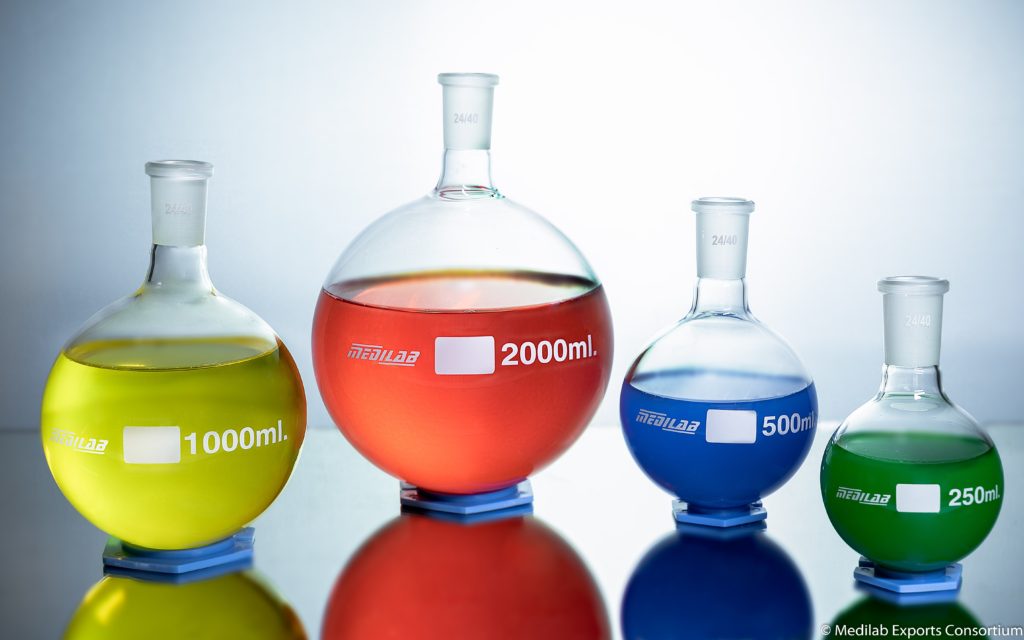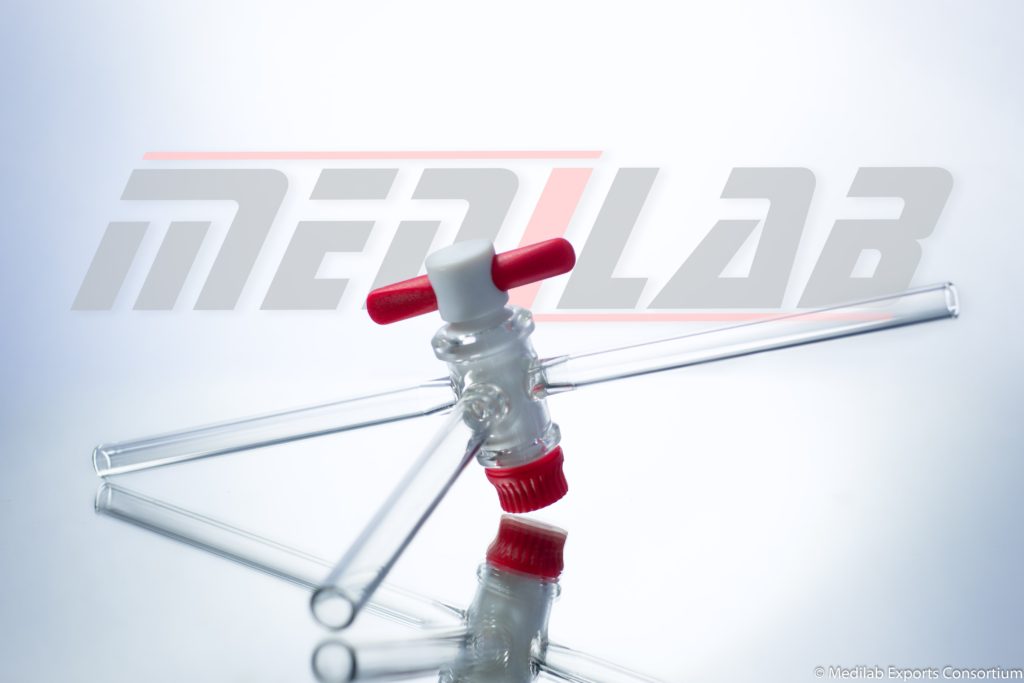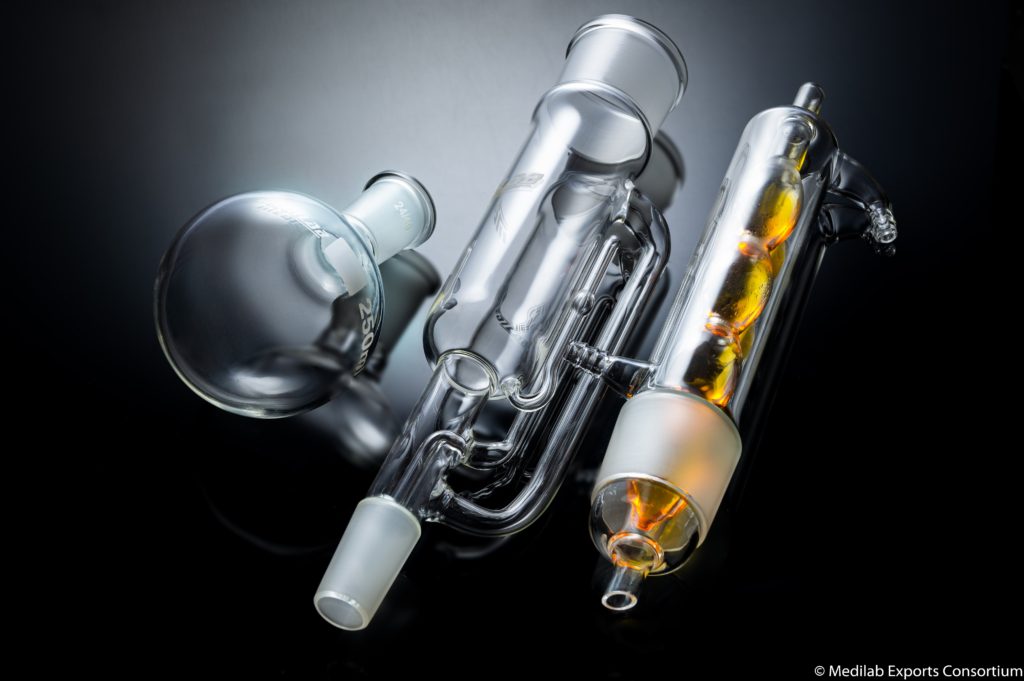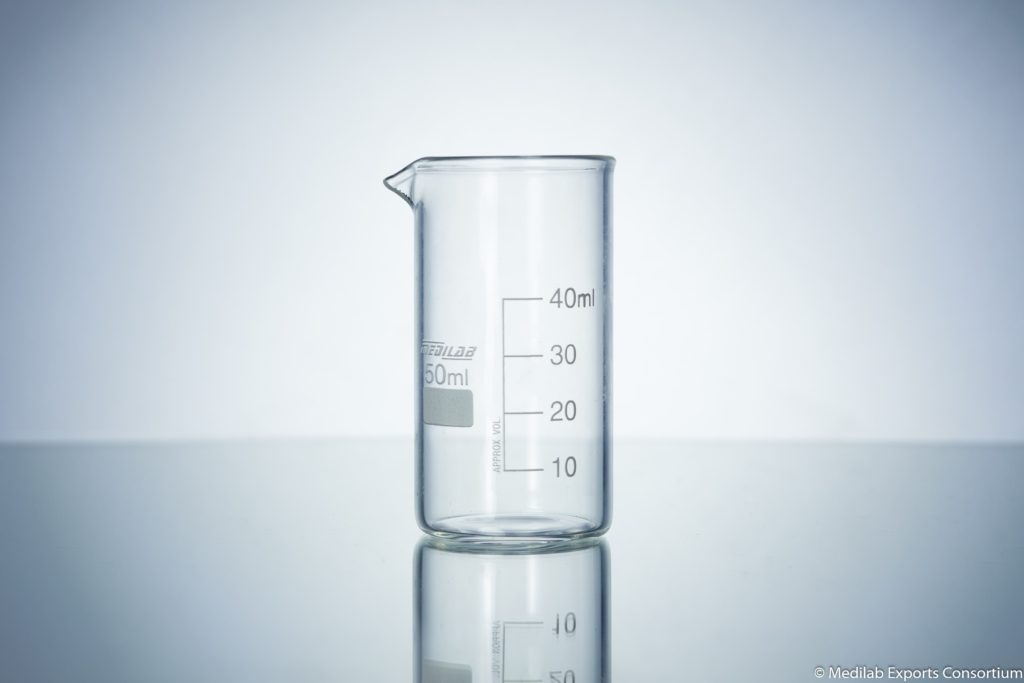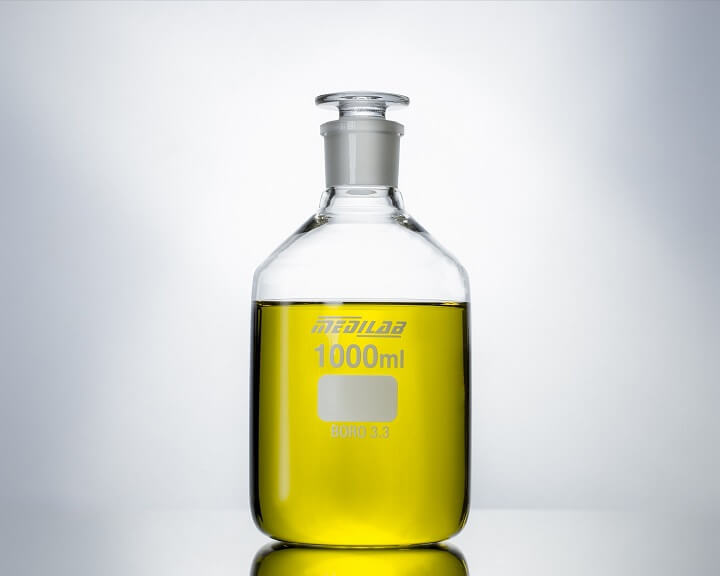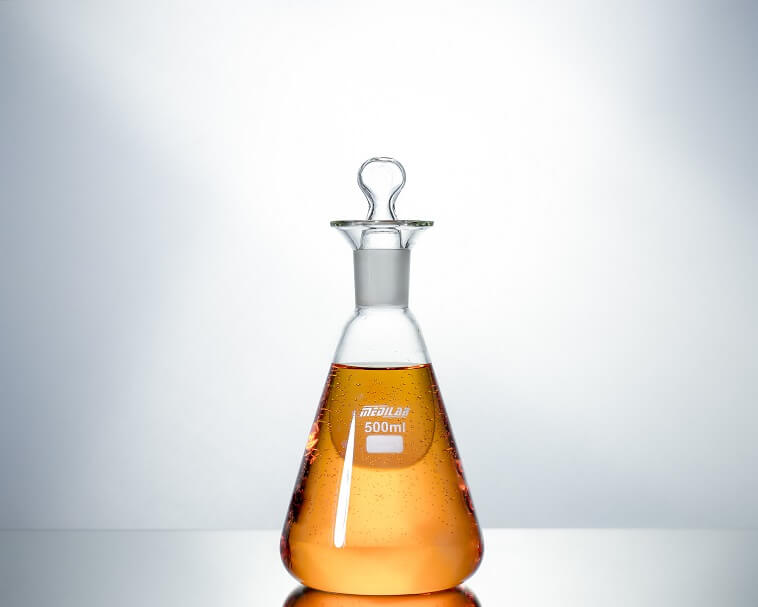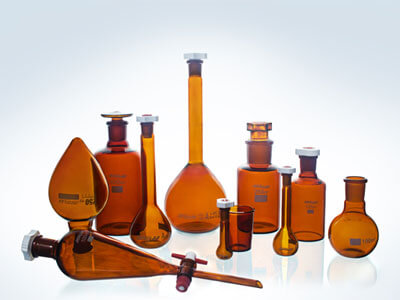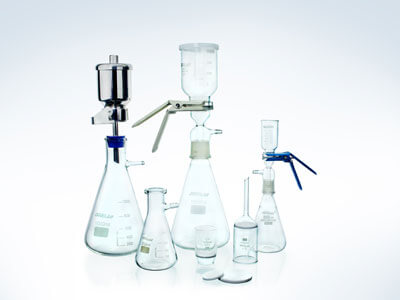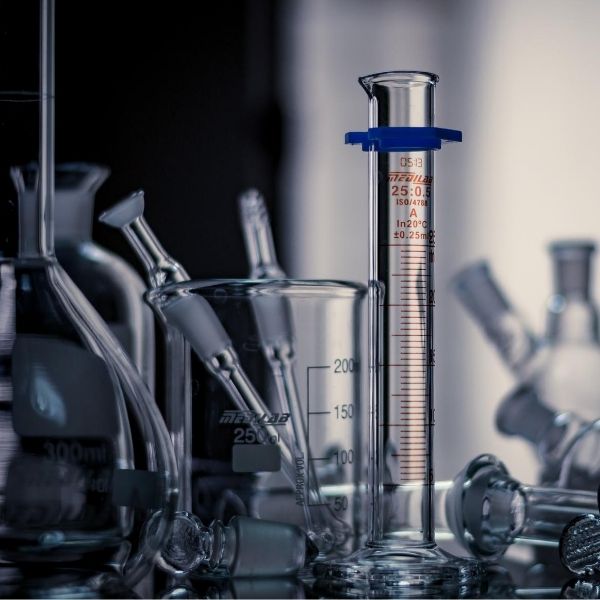Chemistry Lab Glassware is a common requirement for any educational, chemist, analytical, research or pharma laboratory. Also, commonly known as Scientific Glassware, it is mostly used for carrying out several scientific experiments, storage of chemicals or specimens, and measurements.
MEDILAB offers a wide variety of chemistry lab glassware made from high-quality low expansion borosilicate 3.3 glass.

Type of Glass Materials:
Chemistry Lab Glassware can be made of 4 different types of glass materials, each of which possesses different properties and is used for a different application in a laboratory. The most common type of glass material used in any laboratory is ‘Borosilicate 3.3 low expansion Glass‘ which is transparent, can withstand thermal shocks, and is resistant to chemical attack. Heavy-walled Boro. 3.3 Glass, lab glassware is generally used for applications to work with high pressure or vacuum.
Another, type of glass material is darkened brown or Amber-colored borosilicate 3.3 glass, which can block UV and Infrared radiation. This type of glass is generally used in storage bottle containers for reactive chemicals.
Soda-glass is one of the prevailing types of glass, used in the manufacturing of glass containers for beverages, food, and some commodity items. This glass is majorly considered to be used for packaging containers.
Last but not least type of glass material, is Quartz. Also the most expensive of all glass types, it can withstand very high temperatures and is only used in certain specific areas or works in a laboratory.
Cleaning and Storing Your Chemistry Lab Glassware
Cleaning laboratory glassware is somewhat necessary as it works best when it’s clean and free from residue. The lab glassware must be washed and cleaned as soon as we are done with the experimental work to avoid the build-up of residue and stains.
Non-abrasive liquid soap can be used to clean your glassware by hand or the Glassware can be soaked in a detergent solution for a limited time (15-20 mins) to remove the greasy substance and loosen most contaminations. Further residue, if any can be scrubbed with a brush.
When cleaning is finished it is common practice to triple rinse glassware before suspending it upside down on drying racks or by turning it upside down on a paper towel.
It is advisable to store your chemistry glassware in a place where it won’t collect dust.
Types of Glasswares used in a Chemistry Lab and their application:
MEDILAB laboratory glassware is manufactured from Borosilicate 3.3 Glass, which poses properties like higher mechanical strength, transparency, resistance to chemicals, contaminants, and drastic changes in temperature. These properties of borosilicate 3.3 low expansion glass make it the most commonly used glass material for Lab Glasswares for research scientists, students, and biologists.
Beakers:
Beaker is one of the most common pieces of glassware in any laboratory. A cylindrical glass container with a flat base with a spout at its top rim is used to hold solids and liquids. It comes in various sizes as small as (10 mL) to very large (4,000 mL). They can be both graduated or non-graduated.
Conical Flasks:
Conical Flasks are designed so the contents can be mixed or swirled without spilling. They have a conical profile with a narrow tubular neck and a flat bottom.
Erlenmeyer Flask:
Erlenmeyer Flask has a flat bottom with approximate graduations. It has diverse use in laboratories like holding, measuring, mixing chemical, or can be used in simple reflux (boiling) and condensation procedures.
Florence Flask:
Florence Flask is a hybrid between the round bottom and Erlenmeyer flask. Florence Flasks can have either a flat bottom or a round bottom, so their applications vary.
Test Tubes:
Test Tubes are small cylindrical vessels that are used to store, handle, heating, and mixing chemicals. They come in various sizes.
Watch Glass:
The watch glass is used when a high surface area is required for a small volume of liquid. This is a common application for crystallizing and evaporating, as well as other qualitative procedures.
Crystallization Dish:
A crystallizing dish is similar to a beaker without a spout, with a large diameter and short height. Its large surface allows for the solution to evaporate faster, which is necessary when recrystallizing compounds. Crystallization dish is commonly used as a short-term container for liquids in a variety of bath processes (water, acid, or oil).
Measuring Cylinder:
A Class A, calibrated Measuring cylinder is used to measure a nearly precise volume of liquid. Much more accurate and precise than a beaker or flask. Graduated cylinders are pieces calibrated lab glassware “TD”(to deliver), where the delivery volume is important.
Volumetric Flask:
It is a type of laboratory flask, calibrated to contain a precise volume at a specific temperature. These are used for precise dilutions and the preparation of standard solutions. The etched mark on the neck of the volumetric flask signifies the precise volume at the specified temperature. Its volume capacity ranges from 10 mL to 4,000 mL and is larger.
Volumetric Pipettes:
Class A, calibrated Volumetric Pipette or bulb pipette or belly pipettes allows extremely accurate measurement of the volume of a solution. It is calibrated to deliver accurately a fixed volume of liquid. The pipette also has an etched mark denoting a precise volume, color-coded for easy handling, and volume segregation.
Micropipettes:
Micropipettes are similar to volumetric pipettes used for very small volumes from 1 µl to 1,000 µL. The micropipette uses plastic disposable micro tips, which can be re-used under appropriate situations. Comes in two different types, variable or fixed volume micropipette.
Burettes:
The burette is a calibrated glass tube with a valve at one end, for precise delivery. These are commonly used in a variety of titration experiments.
Round Bottom (Boiling) Flasks:
Round-bottom flasks, or boiling flasks, are mostly used in synthesis experiments since the round shape allows for even heating and stirring. The neck of RB Flask is also available with a ground joint that can be attached to a condenser or any other piece of glassware. Flask size ranges from 50 mL to 20,000 mL.
Separatory Funnel:
The Separatory Funnel is used for the separation of liquid from liquid with different densities and solubility. The bottom of the separatory funnel is narrow leading to a stopcock/ Valve, for precise separations of liquids.
Büchner Flask:
It is Similar to the Erlenmeyer flask, having a hose barb near the top for attaching a vacuum hose. The flask has thicker walls than an Erlenmeyer Flask. Buchner funnels can fit into the neck of the flask using a rubber stopper.
Funnels:
Filter Funnel has a wide cone-shaped body, for adding and filtering solutions, and a long narrow stem, for delivery into a flask. Filter paper is used with Filter Funnels for the separation of solids from liquids. The Powder Funnel has a wider stem design for dispensing solids and viscous liquids.
Glass Media Bottles (Reagent Bottle Screw Cap):
Used for a range of general laboratory applications mostly prolonged storage of ph sensitive liquids. They come with a blue autoclavable PE screw cap and pouring ring for drip-free operations. It can also be offered with Teflon liner inside the cap without a pouring ring.
Safe Handling of Lab Glassware:
- Wear aprons, lab coats when manipulating and working with laboratory glassware.
- Do not use chipped or broken glassware as you may get cut. Such glassware also breaks more easily.
- Use safety shields, nets, or coatings to prevent broken glass from hitting you.
- Check all glassware for damage as even small cracks, chips, or scratches as it affects the strength of the glassware.
- Never heat-damaged glassware as resistance to heat is equally compromised.
- Heat up and cool down glassware as slowly as possible even when using Borosilicate glass which
- Maximum working temperature for Borosilicate glass is 500°C
- Special precautions must be employed even when working above 150°C.
- Do not heat extra-thick glassware. This glassware is ideal for working under a vacuum.
- Thin-walled, laboratory glassware must be prevented from applications of pressure or vacuum.
- Glassware must be lifted by the body and not by the area of fragile rims or sidearms.
- Loosen the caps, when heating glass bottles.
- Prevent pipetting by mouth. You may get intoxicated, burn your mouth, or cut your lip.
- Do not use excessive force when trying to free stuck jointed glassware.
- Do not heat glassware to over 420°C. This will cause stress in the glassware that may eventually cause it to break.
